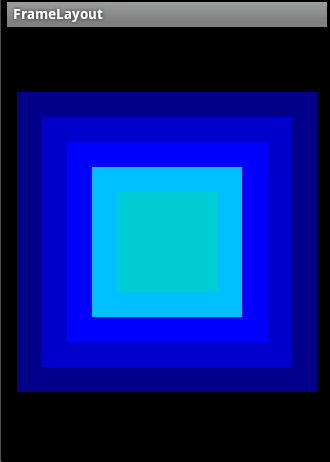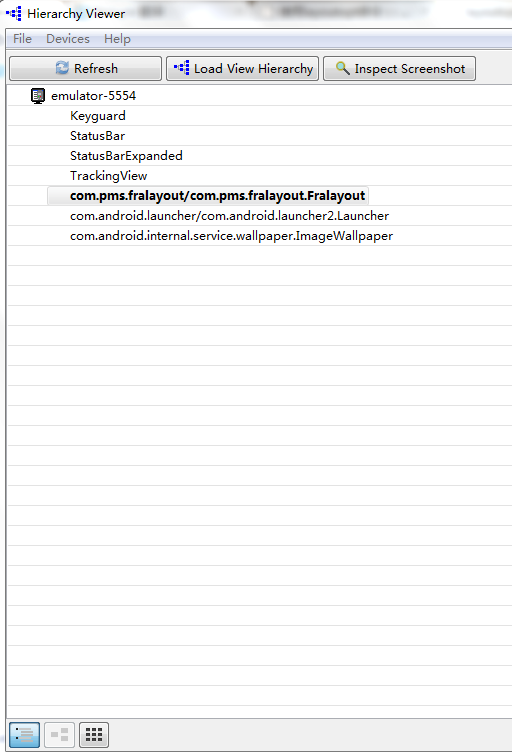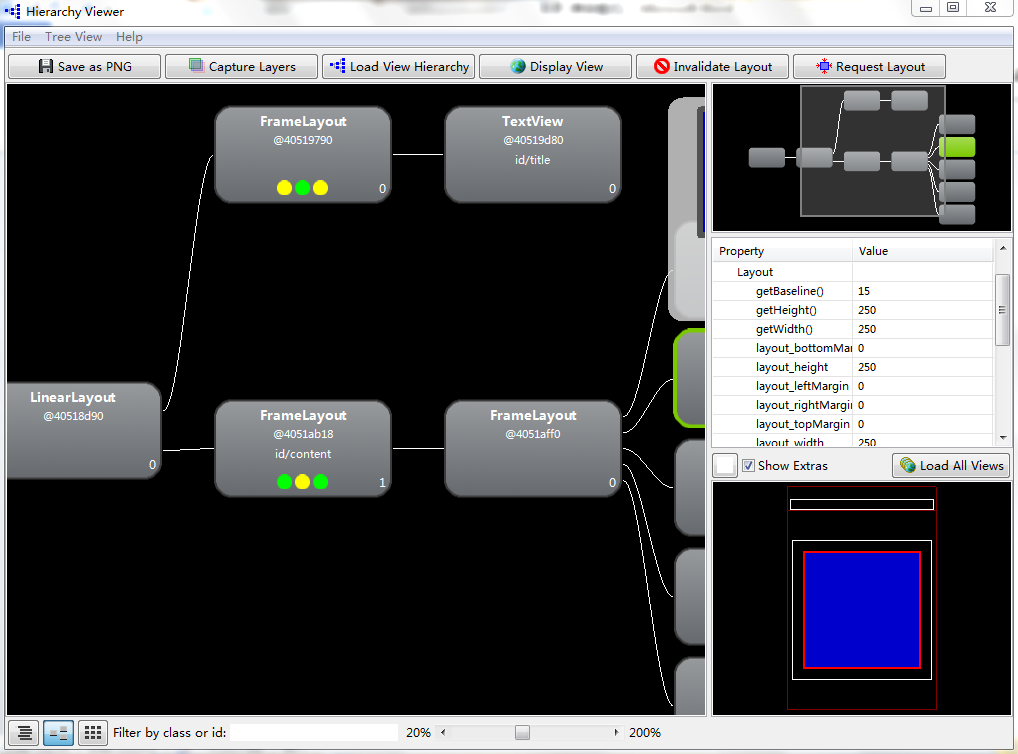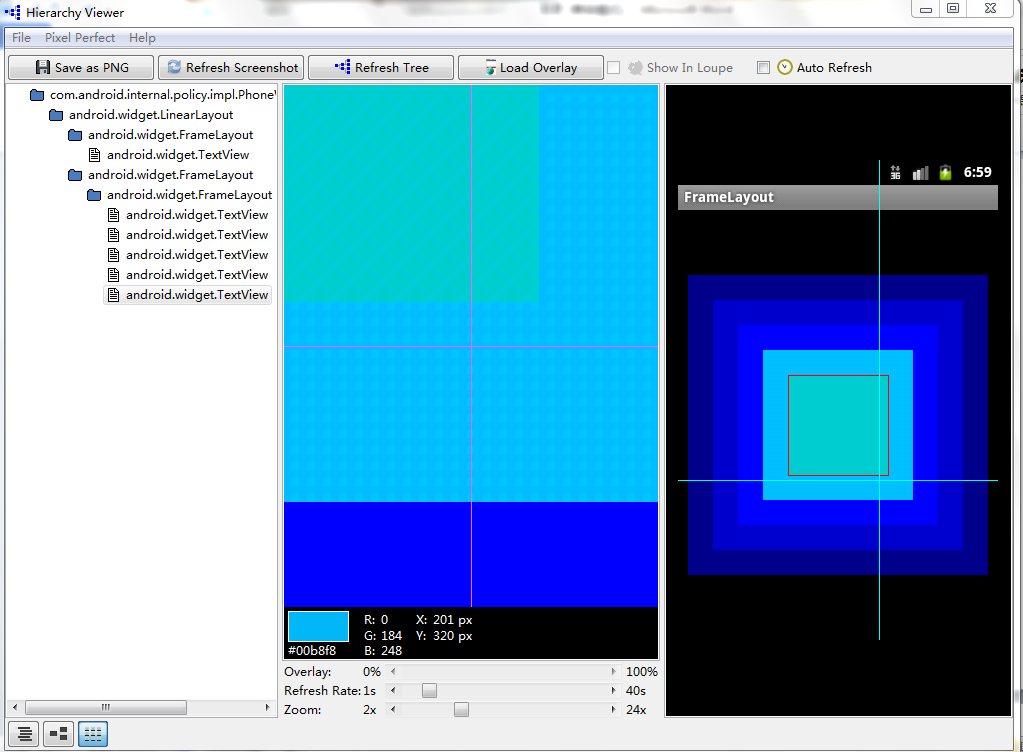http://www.cnblogs.com/noTice520/%E3%80%80
今天来讲下如何使用android中提供的工具优化我们的布局。首先我们写一个最简单的框架布局。
<?xml version="1.0" encoding="utf-8"?>
<FrameLayout xmlns:android="http://schemas.android.com/apk/res/android" android:orientation="vertical" android:layout_width="fill_parent" android:layout_height="fill_parent">
<TextView android:layout_width="300dip" android:layout_height="300dip" android:background="#00008B" android:layout_gravity="center" />
<TextView android:layout_width="250dip" android:layout_height="250dip" android:background="#0000CD" android:layout_gravity="center" />
<TextView android:layout_width="200dip" android:layout_height="200dip" android:background="#0000FF" android:layout_gravity="center" />
<TextView android:layout_width="150dip" android:layout_height="150dip" android:background="#00BFFF" android:layout_gravity="center" />
<TextView android:layout_width="100dip" android:layout_height="100dip" android:background="#00CED1" android:layout_gravity="center" />
</FrameLayout>非常简单的一个布局,实现一个层叠的效果,运行效果如下图:

下面我们就用android中提供的一个观察布局的工具,层级观察器,Hierarchy Viewer来观察我们的布局。Hierarchy Viewer工具是一个非常好的布局优化工具,同时,你也可以通过它学习他人的布局。应该说是一个非常实用的工具。
Hierarchy Viewer在sdk的tools目录下,打开后最新界面如图所示:

界面很简洁,列出了当前设备上的进程,在前台的进程加粗显示。上面有三个选项,分别是刷新进程列表,将层次结构载入到树形图,截取屏幕到一个拥 有像素栅格的放大镜中。对应的在左下角可以进行三个视图的切换。在模拟器上打开写好的框架布局,在页面上选择,点击Load View,进入如图所示界面。

左边的大图为应用布局的树形结构,上面写有控件名称和id等信息,下方的圆形表示这个节点的渲染速度,从左至右分别为测量大小,布局和绘制。绿 色最快,红色最慢。右下角的数字为子节点在父节点中的索引,如果没有子节点则为0。点击可以查看对应控件预览图、该节点的子节点数(为6则有5个子节点) 以及具体渲染时间。双击可以打开控件图。右侧是树形结构的预览、控件属性和应用界面的结构预览。点击相应的树形图中的控件可以在右侧看到他在布局中的位置 和属性。工具栏有一系列的工具,保存为png或者psd,刷新等工具。其中有个load overlay选项可以加入新的图层。当你需要在你的布局中放上一个bitmap,你会用到它来帮你布局。点击左下角的第三个图标切换到像素视图,如下图 所示。

视图左侧为View和ViewGroup关系图,点击其中的View会在右边的图像中用红色线条为我们选中相应的View。最右侧为设备上的原图。中间为放大后带像素栅格的图像,可以在Zoom栏调整放大倍数。在这里能定位控件的坐标,颜色。观察布局就更加的方便了。
接下来再介绍下另一个布局优化工具-layoutopt。这是android为我们提供的布局分析工具。它能分析指定的布局,然后提出优化建议。
要运行它,打开命令行进入sdk的tools目录,输入layoutopt加上你的布局目录命令行。运行后如图所示,框出的部分即为该工具分析布局后提出的建议,这里为建议替换标签。

下面列出一些常会碰到的输出:
$ layoutopt samples/
samples/compound.xml
7:23 The root-level <FrameLayout/> can be replaced with <merge/>
11:21 This LinearLayout layout or its FrameLayout parent is useless
samples/simple.xml 提示未使用到该布局
7:7 The root-level <FrameLayout/> can be replaced with <merge/>
samples/too_deep.xml
-1:-1 This layout has too many nested layouts: 13 levels, it should have <= 10!
20:81 This LinearLayout layout or its LinearLayout parent is useless
24:79 This LinearLayout layout or its LinearLayout parent is useless
28:77 This LinearLayout layout or its LinearLayout parent is useless
32:75 This LinearLayout layout or its LinearLayout parent is useless
36:73 This LinearLayout layout or its LinearLayout parent is useless
40:71 This LinearLayout layout or its LinearLayout parent is useless
44:69 This LinearLayout layout or its LinearLayout parent is useless
48:67 This LinearLayout layout or its LinearLayout parent is useless
52:65 This LinearLayout layout or its LinearLayout parent is useless
56:63 This LinearLayout layout or its LinearLayout parent is useless
samples/too_many.xml
7:413 The root-level <FrameLayout/> can be replaced with <merge/>
-1:-1 This layout has too many views: 81 views, it should have <= 80!
samples/useless.xml 提示该布局中有太多的控件
7:19 The root-level <FrameLayout/> can be replaced with <merge/>
11:17 This LinearLayout layout or its FrameLayout parent is useless